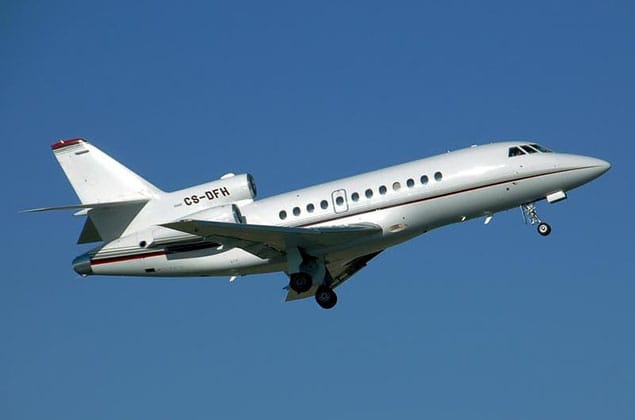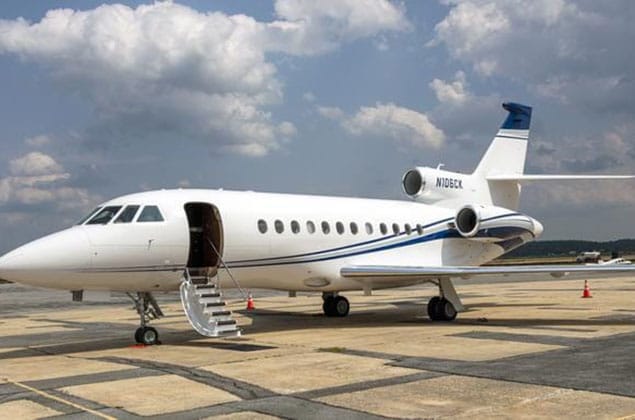Falcon 900 Specifications & Booking
Overview of the Falcon 900
The Falcon 900 is a tri-jet business jet manufactured by Dassault Aviation, a French company. It is a medium-range, long-range aircraft designed for private and corporate use. The first flight of the Falcon 900 took place on February 29, 1976. Notable milestones in its development include its certification in 1984 and entry into service in 1985.
Technical Specifications
The following are the technical specifications for the Falcon 900:
- Dimensions:
- Length: 65.8 feet (20.06 meters)
- Wingspan: 55.3 feet (16.82 meters)
- Height: 17.7 feet (5.39 meters)
- Weight:
- Empty weight: 31,500 pounds (14,250 kilograms)
- Maximum takeoff weight: 51,000 pounds (23,125 kilograms)
- Engines:
- Type: General Electric CF6-50C2F
- Thrust: 15,000 pounds-force each
- Fuel efficiency: 0.65 pounds per horsepower-hour
- Performance:
- Maximum speed: Mach 0.85 (647 mph or 1,041 km/h)
- Range: 4,750 nautical miles (8,800 kilometers)
- Cruising altitude: 41,000 feet (12,497 meters)
- Capacity:
- Passengers: Up to 19
- Cargo: Capacity for 2,500 pounds (1,136 kilograms) of cargo or 300 cubic feet (8.5 cubic meters) of cargo volume
- Crew: Two pilots and one flight attendant
Design and Features
The Falcon 900 features a unique design, including:
- Aerodynamically optimized fuselage for improved performance
- Advanced avionics systems, such as the EFIS (Electronic Flight Instrument System)
- State-of-the-art materials and manufacturing techniques for reduced weight and increased durability
- Fully pressurized cabin with air conditioning and pressurization system
- In-flight entertainment system with LCD screens and DVD player
- Enhanced safety features, including a redundant flight control system and emergency oxygen system
History and Development
The development of the Falcon 900 began in the late 1970s:
- First flight on February 29, 1976
- Certification by the Federal Aviation Administration (FAA) in 1984
- Entry into service in 1985 with launch customer, NetJets
- Significant upgrades and variants include:
- Falcon 900EX: Enhanced version with improved performance and range
- Falcon 900DX: Demonstrator variant for testing new technologies
Operational Use
The Falcon 900 is used in various operational scenarios:
- Airlines and organizations that operate the Falcon 900 include NetJets, TAG Aviation, and Gama Aviation
- Popular routes and missions include:
- Scheduled flights between major cities around the world
- Private charters for corporate events and VIP transport
- Military operations, including reconnaissance and transport missions
Interesting Facts
Here are some interesting facts about the Falcon 900:
- The Falcon 900 set multiple records for speed and distance during its testing phase
- The aircraft has been featured in several films and television shows, including the James Bond movie "The World Is Not Enough"
- The Falcon 900 is capable of flying at an altitude of over 50,000 feet (15,240 meters) with a service ceiling of 51,000 feet (15,545 meters)
Frequently Asked Questions
What makes the Falcon 900 unique?
The Falcon 900 is unique due to its tri-jet configuration and advanced aerodynamics, which provide improved performance, range, and efficiency. Its spacious cabin and high-altitude capabilities also set it apart from other business jets.
How much does the Falcon 900 cost?
The price of a Falcon 900 can vary depending on factors such as configuration, customization, and condition. On average, a pre-owned Falcon 900 can cost between $5 million to $10 million, while a new one may cost upwards of $20 million.
What is the range of the Falcon 900?
The Falcon 900 has a maximum range of approximately 4,750 nautical miles (8,800 kilometers), making it suitable for transcontinental and intercontinental flights.
How many passengers can the Falcon 900 carry?
The Falcon 900 can accommodate up to 19 passengers, depending on the configuration and seating arrangement chosen by the operator.
What is the service ceiling of the Falcon 900?
The service ceiling of the Falcon 900 is approximately 51,000 feet (15,545 meters), allowing it to operate at high altitudes for extended periods.





